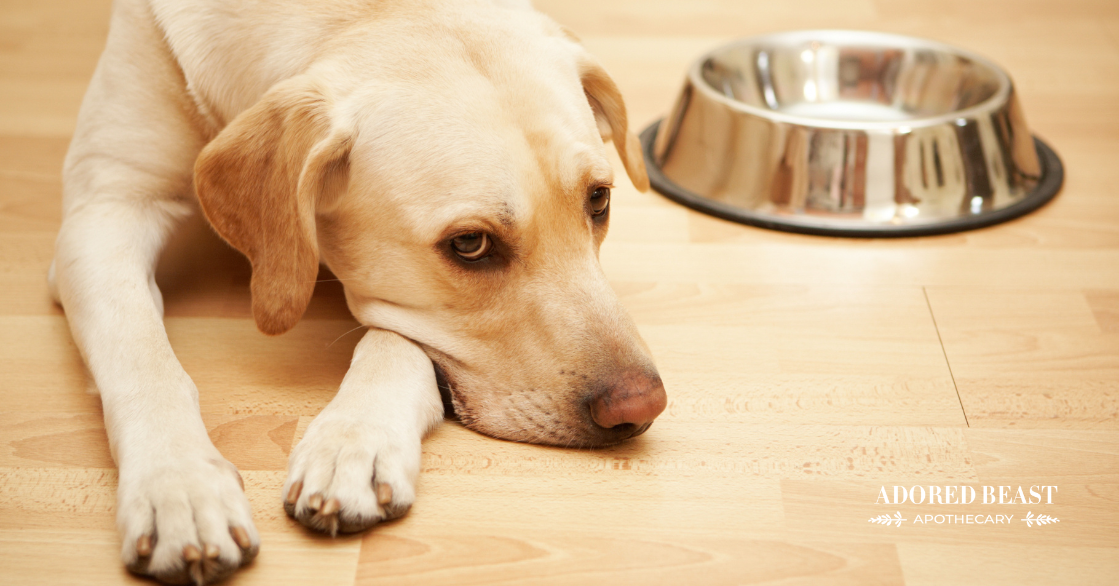I’ve been feeding raw food to my animals for almost 30 years. I started out following feeding basics from experts like Dr. Ian Billinghurst, and eventually my experience and knowledge grew.
When I opened my clinic in Vancouver, it was the first licensed veterinary clinic in Canada to sell raw food. We recommended raw food, and because of this, we were heavily scrutinized and monitored. Any time an animal became sick, raw food (and our clinic) was blamed. Even things that were not even remotely tied to diet were laid at our feet. As a result, I had to be so careful. I wasn’t about to give up, but I also wasn’t about to put my head on the chopping block.
But this turned out to be a good thing. It meant that I learned to pay very close attention to the fact that all dogs shouldn’t be transitioned the same way, especially when they’re sick. Sick dogs may need a different diet than healthy dogs.
When a dog is healthy, a species appropriate raw food diet provides the greatest access to vitamins, minerals, and nutrients. It is, in my opinion, the best way to feed a pet. But what about when a dog isn’t feeling well, or is struggling with a health condition? One of the things that I find people struggle with when it comes to feeding is how to manage raw food for a sick dog.
In this post, I want to talk about raw feeding, and how to reintroduce raw food, especially after an acute and chronic illness. It’s important, as we want to best support our animals when they’re not feeling well.
When Raw Food for a Sick Dog is Recommended
Sometimes, depending on the illness, raw food for a sick dog can play a big role in the healing process. A diet rich in certain elements (along with other supportive remedies) can help bring a body back to balance.
Autoimmune Diseases
For example, I would say that any autoimmune disease responds incredibly well to raw food, including:
- Cushing’s disease
- Arthritis
- Hypothyroidism
- Skin disease
- Addison’s disease
Any time you see chronic inflammation, arthritis as the perfect example, the addition of raw food to the diet is probably the number one thing you can do to decrease inflammation.
This is as long as they are not on major amounts of immunosuppressive drugs. In this case, it’s important to go more slowly with the introduction of raw food, and use species oriented probiotics that produce metabolites that fight bacteria such as E. coli, salmonella, and clostridium. This is because immunosuppressive drugs suppress the immune system so the body is a little more susceptible to bacteria.
That being said, when a dog eats a fresh food diet, it strengthens their immune system. Many times I’ve put dogs on raw food with species oriented probiotics and they were able to come off the immunosuppressive therapy incredibly fast! (You have to work with a vet when decreasing any medication – that’s a must. Please don’t do this on your own).
Other Illnesses
Other illnesses that I’ve seen greatly benefit from raw:
- Liver and kidney disease
- Cancer (in most situations, more detail below)
People are so afraid with kidney disease and liver disease to put animals on raw food, but you just need to find the correct proteins and vegetables, along with the correct ratios of each. But honestly, in my opinion, you can’t find a better food for organ diseases than a species oriented raw diet.
When a Break is a Good Idea
Sometimes raw food for a sick dog can be very helpful. Other times, though, it may need to be held off for a length of time to give the body time to gently heal.
In my clinic (and with my own animals), if we had an acute situation like pancreatitis, diarrhea, vomiting, or chemical toxicity, I would always recommend stopping raw food for a time.
Instead, I would suggest a slow-cooked soup broth, paying crazy attention to the amount of fat (like zero!). I suggest doing this until their systems are completely back to normal. Additionally, I would add in homeopathic remedies, herbs, and probiotics.
Then, once symptoms are gone, I slowly introduce the raw by cooking it less and less until they’re completely on raw once again. (Make sure that if you’re feeding commercial raw, you don’t cook raw with bone in it). While you do this, be sure that their stools and G.I. are normal. If they relapse, then go back to gently cooking the food, and reintroducing the raw more slowly.
For example, if you’re feeding 100% cooked, move to 90% cooked and 10% raw for 2 days. Then go to 20% raw for 2-3 days. Then 30%… But if, at 30%, they start getting diarrhea, or the symptoms return, go back to 90% and stay there for a while. Watch closely, use your common sense, and listen to your dog.
The biggest thing here is to go slow. Seriously, the turtle wins the race. So, for example, if you’re dealing with a dog with cancer and they’ve had a relapse or situation that you’re dealing with, you just have to be mindful that you don’t want to exacerbate something that’s already hitting them pretty hard. Just go slow and watch for symptoms of increased stress, panting, drinking too much, etc., and if you see that then you have to back off again.
Watching for Results
In both cases (starting or stopping raw food for a sick dog), you want to pay attention to any changes in health status.
If you don’t see the results you think you should, try playing around with different proteins, different ratios, different types of cooling vegetables, heating vegetables, etc. Work with an herbalist or traditional Chinese medicine doctor if your dog is running hot or cold and then feed the appropriate foods to either increase heat or cold. Dr. Judy Morgan has great resources on this.
If your animal gets worse, stop right away and reassess. Reach out to a nutritionist, especially someone who deals with the energetics of the food in comparison to just what to feed/what not to feed and what’s balanced/not balanced.
After treating the thousands of animals that I worked with in my hospital, I firmly believe that if a dog gets worse on a raw food there is a bigger underlying issue. Most often, that problem I would say is in the gut microbiome, and more than likely leaky gut is at play. You can address this at the same time you’re transitioning to raw food.
What About Raw Bones?
Raw bones form an important part of a species appropriate diet. They provide essential nutrients and vitamins that you can’t miss out on.
However, with regard to raw food for sick dogs, I don’t recommend bones for any type of G.I. illness. If your dog’s not producing enough acid, or they’re producing too much acid, or their pancreatic enzymes aren’t working correctly, or they have inflammation in their intestinal lining, the bones may not be assimilated or digested correctly. This can just add stress to the body, which isn’t good for healing at all!
Because we recommended raw bones at my veterinary clinic, I had to be hyper diligent about them. I became very careful, and quite quickly recognized that it actually was a really good thing because I was having more success taking them off of bones until their bodies fully healed.
Immunosuppressive drugs, chemotherapy, and radiation are other things we need to consider with raw bones. These types of drugs have a tendency to wreak havoc on the natural digestive system of the body. I don’t recommend raw, meaty bones in these cases, but do recommend soft bones like chicken and turkey necks.
Another one is kennel cough. I take dogs off bones for a really long time with kennel cough. Anything dry or rough just exacerbates the cough, and then the cough exacerbates the lining of the trachea. This can make the kennel cough last longer. It’s the same idea as not putting a collar on your dog if they have kennel cough. You should avoid anything that’s going to create more inflammation in the trachea. Definitely no dry food or cookies! Go with soft raw and gentle bone broth.
[RELATED] When a dog is healthy, raw bones can be so beneficial! Read more on them here.
Raw Food for a Sick Dog: Things to Remember
When our animals are sick, we tend to get stressed out and sometimes that makes us forget certain things! Just breath, relax, and remember, you know your dog better than anybody!
These are a few more of my top tips:
- Don’t get caught up with what conventional veterinary medicine tends to say about raw or home cooked food. A cooked diet of real food is exponentially a million times better than a commercially-based, processed diet.
- If you’re normally a raw feeder, but have to go to a cooked diet, that’s ok!! Do Not Get Freaked Out! It’s still really, really good for your dog!
- Feed an appropriate amount of organs that support the organs or the disease process that your dog is experiencing.
- Go slow – there is absolutely no need to rush! Take your time and bring them back according to your own individual dog’s needs. Do not feel like you have to jump right back in and start feeding them raw.
And probably most importantly, if they’re really sick, sometimes you have to NOT feed raw. Sometimes you have to follow your dog’s lead and continue to feed cooked for the long haul or even forever. It’s incredible how much our dogs can tell us about what they need and what they don’t need.
Listen, listen, listen…
If you feed them something and they get worse or they don’t get better, listen to them. I’ve seen some dogs so sick and they refuse raw food, but their people are so determined that they have to feed raw food that their dogs often don’t even eat or the dog is forced to eat. But let me tell you, I grew up on a farm with big dogs living well into their late teens. When they weren’t feeling well, my grandmother fed them cooked oatmeal with raw milk and homemade bread soaked with raw milk. For sick animals, giving them the things that they love to eat, food that was real and not processed, and given with love made a huge difference. They ate it and it did something energetically to them.
And that’s what I found with thousands of my cancer patients. You don’t know in the end how much time they have, and to force them to eat raw food when they can’t stomach it or they don’t want it… that’s not helping anyone. Listen to them. Try new foods to see if they’ll like them, let them transition at their own pace. Give the very best versions of things that they will eat (raw milk, organic, steel cut oats, the very best treats, etc.) Sometimes in a few days or weeks, they’ll surprise you by wanting the meat back in their diet. Give them the best food you can, food that they’ll eat, and accompany it with lots of love and support.












